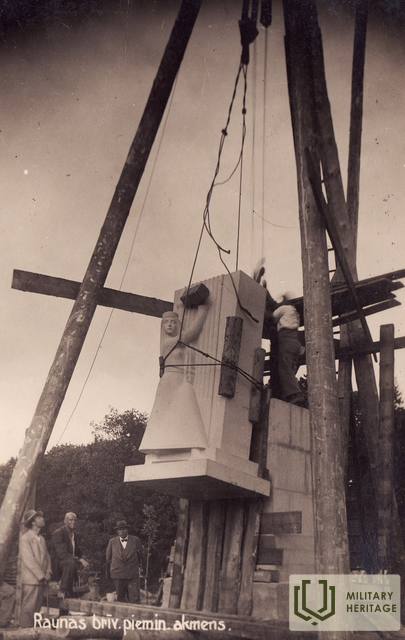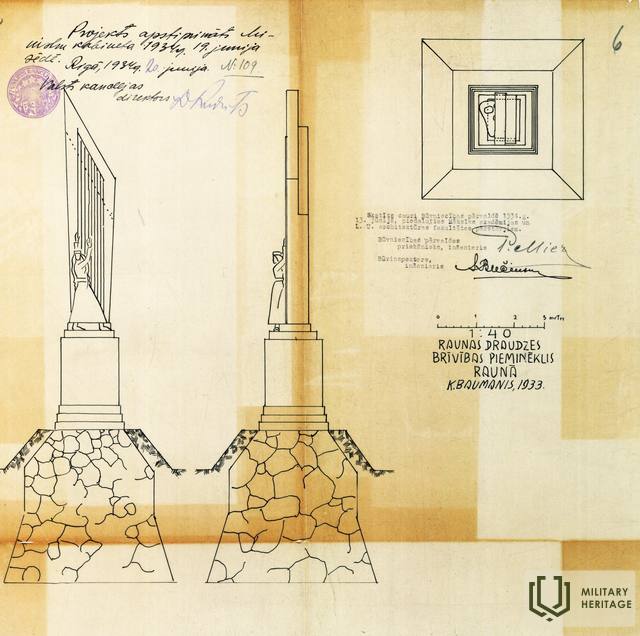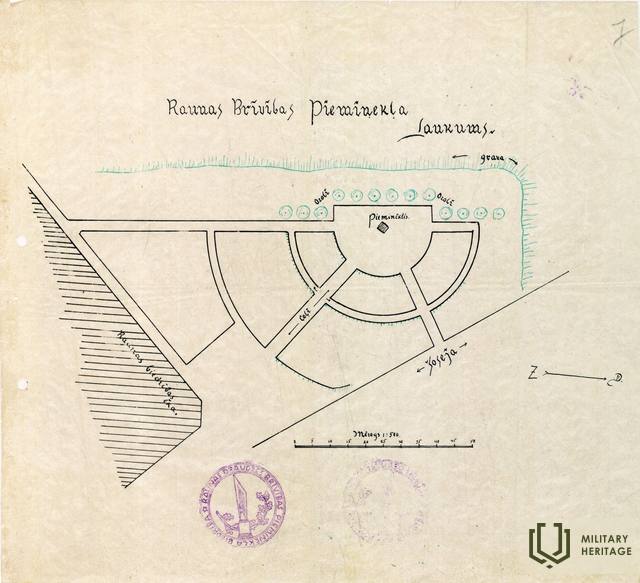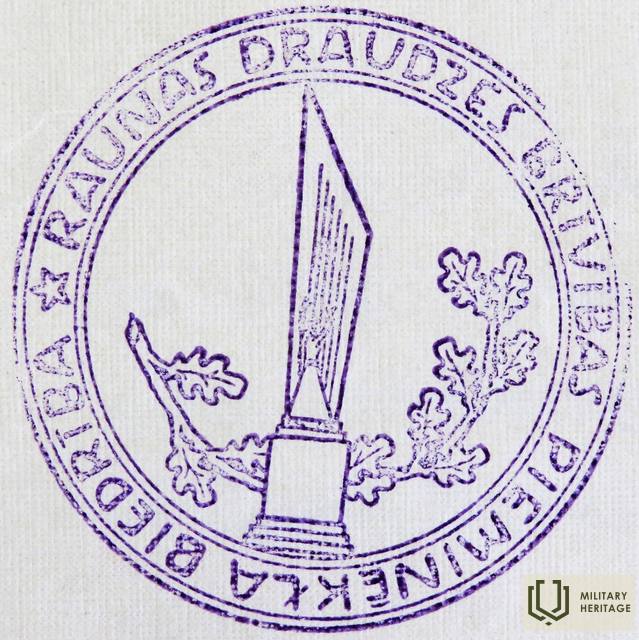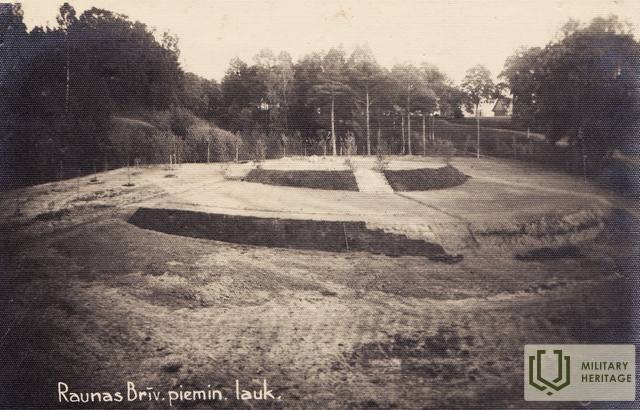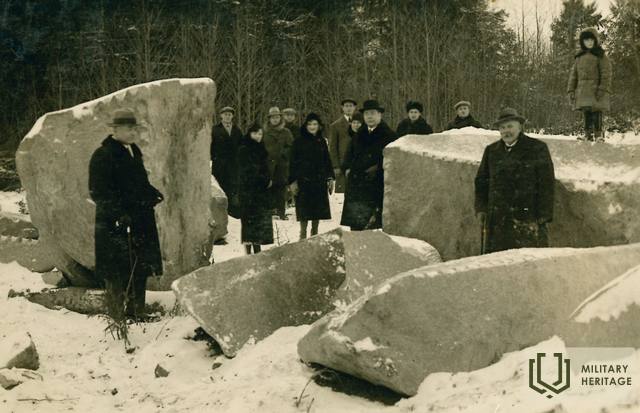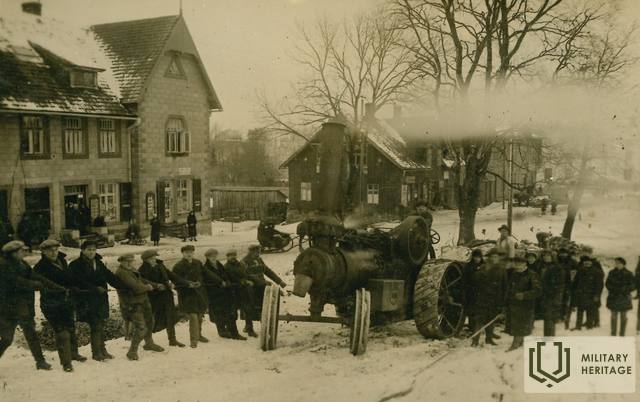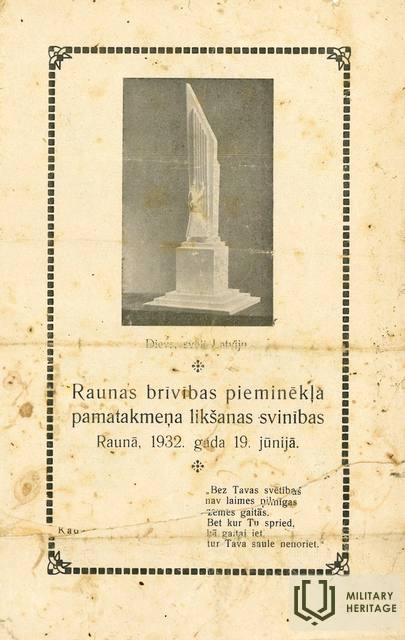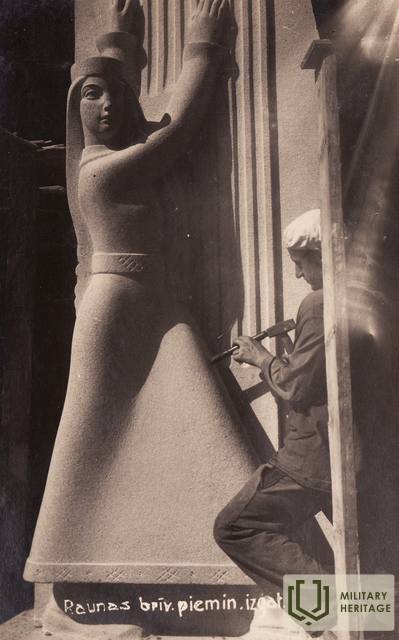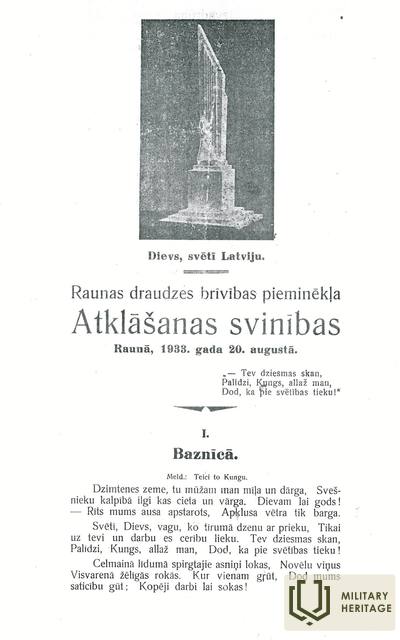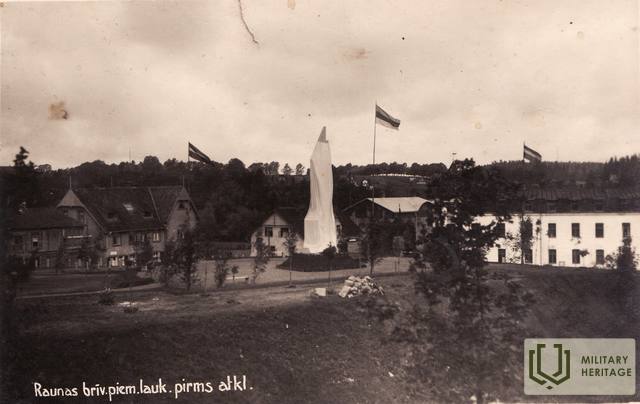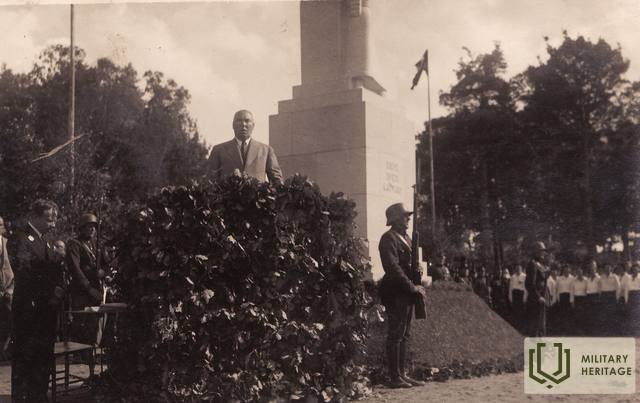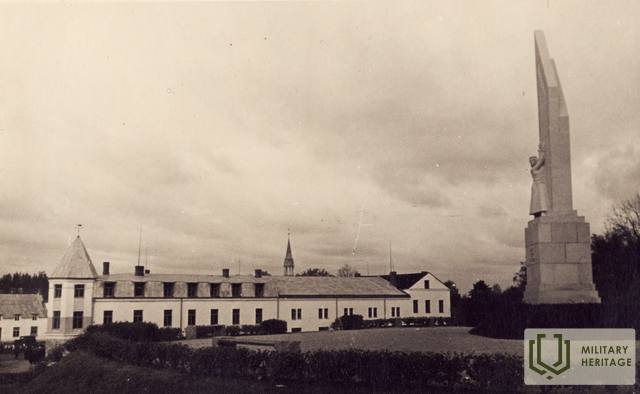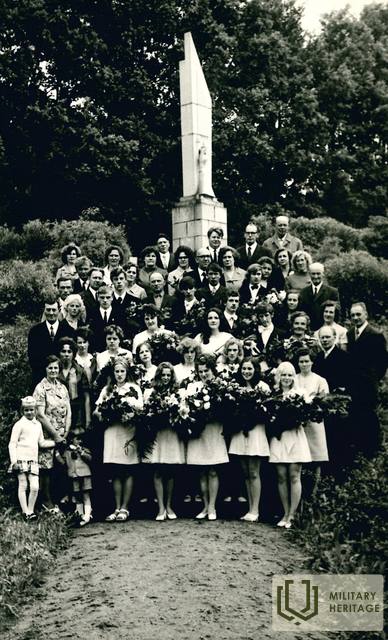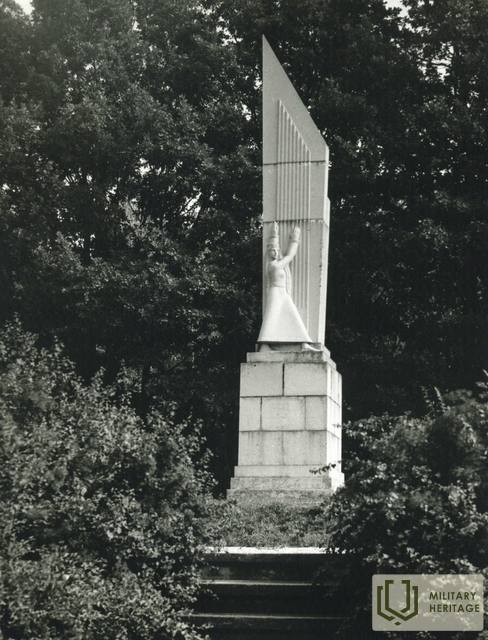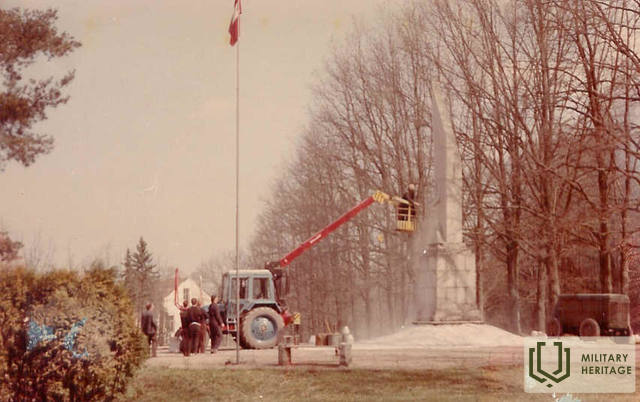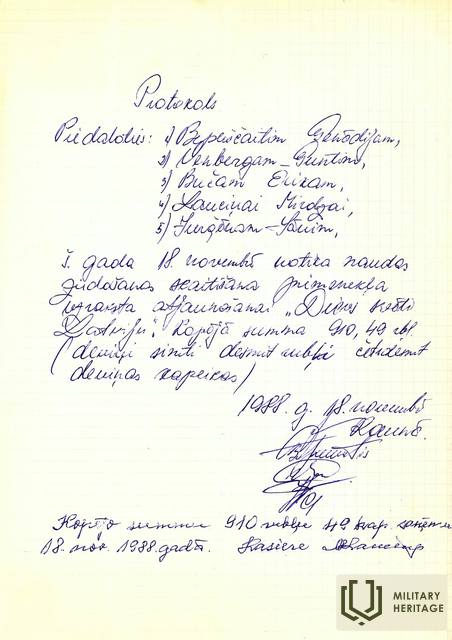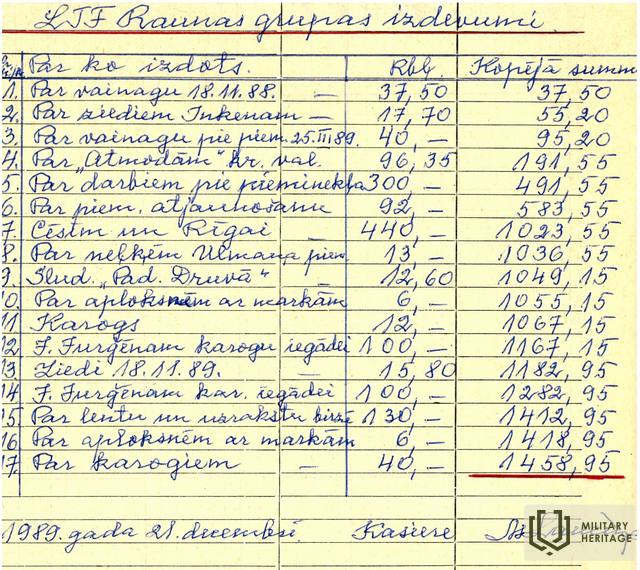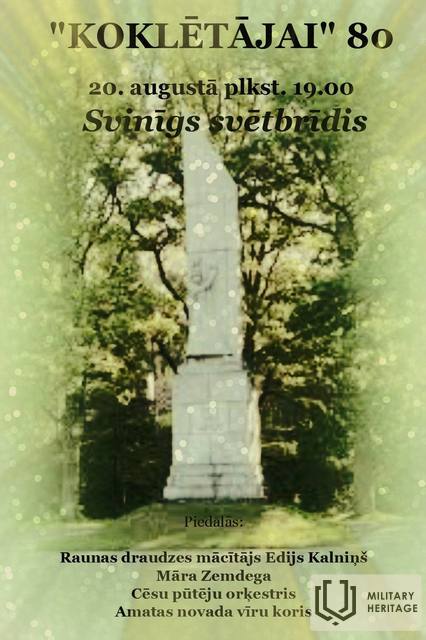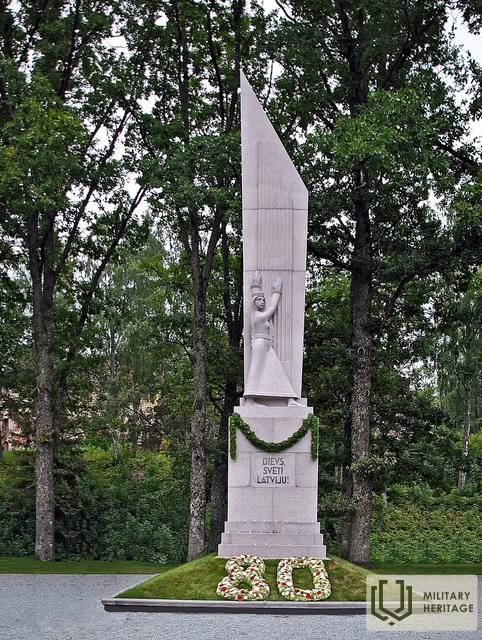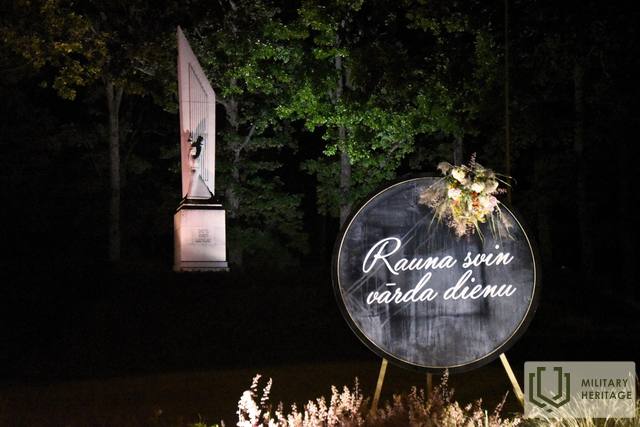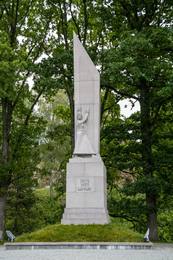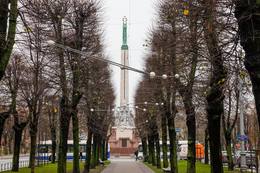Raunos laisvės paminklas arba paminklas Pirmajame pasauliniame kare ir Laisvės kovose žuvusiems Raunos parapijos nariams atminti
Raunos Laisvės paminklo idėjos ištakos siekia 1929 metų rugpjūčio 21 dieną, kai Cėsių meras ir Cėsių rajono vadovas į susitikimą pakvietė iškiliausius Raunos parapijos visuomenės veikėjus, pakvietę pagerbti laisvės pasiekimą ir pastatyti paminklą Raunoje.
Tam iš Šiaurės Latvijos išsivadavimo kovos memorialinio komiteto sostinės buvo skirta 1200 LVL. Iš susirinkusių Raunos visuomenininkų buvo išrinktas laikinasis trijų žmonių prezidiumas, kurio užduotis buvo populiarinti Laisvės paminklo pastatymo idėją ir organizuoti kitų žmonių įsitraukimą.
1929 m. spalio 13 d. buvo sušauktas susirinkimas, kuriame dalyvavo įvairių Raunos visuomeninių organizacijų atstovai, kurie nusprendė steigti naują organizaciją ir pavadino ją Raunos ir apylinkių išvadavimo paminklo komitetu. Komiteto pirmininku išrinktas klebonas Arvīds Treici, iždininku – mokytojas Eduardas Auksas, sekretoriumi – J. Grīslis.
Viena pirmųjų naujojo komiteto užduočių buvo surasti vietą paminklui pastatyti. Paminklui tinkamiausia ir naudingiausia vieta buvo pasirinktas Raunos parapijos tarybai priklausantis sklypas tarp Raunos pilies griuvėsių, Žemės ūkio draugijos namų ir Rygos plento. Įdomu tai, kad po 20 a. Praėjusio amžiaus ketvirtajame dešimtmetyje spaudoje pasirodžiusioje informacijoje buvo minima pirminė ir galima paminklo vieta – Rauna Tanīsa kalnas, kuris „leistų paminklą matyti iš tolo“.
Sudėtingiausia ir daugiausiai laiko reikalaujanti komiteto užduotis buvo surinkti lėšas, reikalingas paminklo statybai. Buvo renkamos aukos, rengiami turgūs, loterijos, renginiai, teatro vaidinimai, siunčiami asmeniniai kvietimai įvairioms organizacijoms aukoti didesnes pinigų sumas. Iš viso paminklo statybai ir aikštės sutvarkymui surinkta apie 8000 Lt. Didžiausi aukotojai buvo Šiaurės Latvijos išsivadavimo kovų memorialinis komitetas (1200 Lt), Raunos taupomoji ir paskolos draugija (1669,50 Lt), Raunos-Baižkalno pienininkų draugija (550 Lt), Raunos savitarpio draudimo nuo gaisro draugija (350 Lt), Kultūros fondas000 Lt (350 Lt). Likusi suma buvo surinkta iš renginių ir privačių aukų.
1930 metų rudenį Raunos ir apylinkių išvadavimo paminklo komiteto atstovai vyko į Rygą pas Respublikos Prezidento sekretorių apžiūrėti Rygos laisvės paminklo projekto konkurso darbų. Rauniškių dėmesį ypač patraukė apdovanotas jauno skulptoriaus Kārlio Baumanio (Zemdega) juodraštis „Es-dūr“, kuris Rygos laisvės paminklo konkurse laimėjo III vietą. Paminklo idėja tokia, kad ietis virsta kokle, kovinė dvasia susilieja su daina. Po diskusijų su projekto autoriumi Raunos ir apylinkių išvadavimo paminklo komitetas 1931 m. spalio 18 d. posėdyje nusprendė Raunoje pastatyti paminklą skulptoriaus K. Baumanio (Žemdega) vardu, naudojant vietinį granitą. Paminklui tinkamas akmuo rastas maždaug už 4 km nuo Raunos centro, prie buvusio Lorenčių pusdvario. Viena iš sunkiausių užduočių buvo sunkių akmenų perkėlimas į Rauną.
Lygiagrečiai komitetas dirbo ir prie paminklo aikštės kūrimo – kasė piliakalnį, kūrė terasas, įrengė laiptus, sodino medžius ir krūmus. 1932 m. pavasarį komitetas organizavo paminklinės ąžuolų alėjos įveisimą paminklo aikštėje. Kiekvienas pasodintas ąžuolas yra atminimas vienam iš Laisvės kovose žuvusių Raunos parapijos narių. Po kiekvienu pasodintu ąžuolu buvo palaidotas butelis su mirusio Raunos parapijos nario pavarde ir trumpa biografine informacija. 1932 m. liepos 19 d. įvyko iškilmingas paminklo pamato akmens padėjimas. Paminklo pamatai buvo įkasti apie 10 pėdų, kartu su iškilmingai pasirašytu aktu, monetomis, laikraščiais ir kitais daiktais.
Siekdamas sėkmingiau spręsti paminklo statybai reikalingo finansavimo klausimą, Raunos ir apylinkių išvadavimo paminklo komitetas nusprendė tapti oficialia organizacija ir registruotis kaip Raunos parapijos Laisvės paminklo draugija. 1933 05 21 buvo išrinkta naujosios asociacijos valdyba. Draugijos pirmininku tapo klebonas Arvīds Treicis, sekretoriumi – mokytojas Jēkabs Pinnis, iždininku – mokytojas Eduardas Auka, nariu – gydytojas Rūdolfas Skaidrais, vicepirmininku – D. Muižnieks. Vienas pagrindinių naujosios valdybos uždavinių buvo 1933 metų rugpjūčio 20 dieną surengti paminklo atidarymo šventę.
1933 metų rugpjūčio 20 dieną įvyko Raunos Laisvės paminklo atidengimo šventė. Renginys prasidėjo iškilmingomis pamaldomis Raunos bažnyčioje, kur kalbas sakė Latvijos universiteto Teologijos fakulteto dekanas profesorius Voldemaras Maldonis, Jaunpiebalgos klebonas Jānis Ozols ir Raunos parapijos klebonas Arvīds Treicis. Tarnyboje pasirodė Raunos apylinkių chorai, vadovaujami Rūdolfo Skaidros ir 8-ojo Daugpilio pėstininkų pulko orkestras.
Po pamaldų įvyko iškilmingas Latvijos prezidento Alberto Kviešo pasveikinimas ir paminklo atidengimas. Latvijos prezidentas Alberts Kviesis, generolas Krišjānis Berķis, Cėsių apskrities viršininkas Jānis Štucers, Cėsių apskrities valdybos pirmininkas Kārlis Līkums, arkivyskupas Teodors Grīnbergs, Valkos apskrities dekanas Kārlis Kundziņs, Estijos laikinasis atstovas Latvijoje Jans Melders, Latvijos universiteto rektorius Jūlijs Auškāps ir kt. Po iškilmingų kalbų ir paminklo atidarymo šventė tęsėsi prie Raunos pilies griuvėsių, dalyvaujant Raunos ir apylinkių chorams bei Daugpilio 8-ojo pulko orkestrui. Po paminklo atidengimo veiklą tęsė Raunos parapijos Laisvės paminklo draugija, rinkusi lėšas tolimesniam paminklo aikštės sutvarkymui.
Po paminklo atidengimo jis tapo vienu iš Raunos visuomeninio ir kultūrinio gyvenimo centrų bei Raunos simboliu. Prie Laisvės paminklo buvo organizuojamos visos pagrindinės šventės ir renginiai Raunos parapijoje iki 1940 m. XX a. Trečiajame praėjusio amžiaus dešimtmetyje Raunos centrinių mokyklų moksleiviams tapo gražia tradicija mokslo metų pradžioje padėti gėles prie paminklo.
Tarybiniais metais buvo konservuotas Raunos laisvės paminklas; sunaikintas tik užrašas ant paminklo „Dieve, palaimink Latviją“. Per tą laiką prie paminklo nevyko jokie renginiai, jo teritorija buvo apleista ir apaugusi. Nepaisant to, kad prie paminklo renginiai nevyko, paminklas matomas daugelyje sovietmečiu darytų fotografijų. Tai galima paaiškinti tuo, kad paminklo aikštės teritorijoje esantys laiptai dažnai buvo naudojami grupinėms nuotraukoms. Žmonių prisiminimuose iki šiol gyvi keli pasakojimai apie paminklo išgelbėjimą nuo sunaikinimo ir jo išsaugojimu besirūpinusius žmones. XX a. 70-80-ieji Devintajame dešimtmetyje Latvijos sodininkystės ir bitininkystės draugijos Cėsių rajono skyriaus Raunos pirminės organizacijos nariai daug dėmesio skyrė paminklo teritorijos sutvarkymui. Nepaisant to, kad sovietiniais metais prie paminklo buvo draudžiama burtis, paminklo papėdėje žmonės slapta padėjo žvakutes ir gėles.
Atgimimo metu XX a. Devintojo dešimtmečio antroje pusėje paminklas tapo laisvės ir nepriklausomybės simboliu, čia vyko įvairūs renginiai. Pavyzdžiui, 1988 metų lapkričio 18 dieną Latvijos liaudies fronto Raunos grupė prie paminklo surengė Latvijos paskelbimui skirtą renginį, prie paminklo esančiame stiebe vėl plevėsavo raudona, balta ir raudona vėliava. Latvijos liaudies fronto Rauno grupės aktyvistų ir gyventojų suaukotų lėšų dėka 1989 metų pavasarį paminklas buvo nuvalytas, sutvarkyti teritorijoje esantys laiptai, restauruotas akmentašis Ansis Rozenbergs istorinis užrašas „Dieve, laimink Latviją“.
Paminklas ir jo teritorija naujai įkvėpė 2011 m., kai, pasinaudodama LEADER programos finansavimu, Raunos apskrities taryba sutvarkė ir sutvarkė paminklo teritoriją ir želdinius bei atliko paties paminklo restauravimą. Kasmet lapkričio 11-ąją prie paminklo dedamos žvakutės ir atminimo akimirka pagerbiami Laisvės kovų dalyviai. Pastaraisiais metais bendruomenės dviračių žygiai organizuojami gegužės 4 dieną nuo Rygos laisvės paminklo iki Raunos laisvės paminklo. Šiandien paminklas yra vienas ryškiausių Raunos ir Latvijos laisvės simbolių.
Raudona E. „Kur Rauna…“, SIA „Latgales druka“, 2015 m.
Straipsniai periodinėje spaudoje
Raunos bibliotekos kraštotyros medžiaga
Raunos muziejaus medžiaga
Atsiminimai apie Birutę Kuncinę, užrašyti 2020 m. rugpjūčio 11 d
Ilonos Rekmanės prisiminimai, parašyti 2020 m. rugsėjo 18 d
Susijusi laiko juosta
Susijusios temos
Susijusios vietos
Freedom Monument in Rauna
The monument, created by the sculptor Kārlis Zemdega, is dedicated to the memory of the members of Rauna parish who fell in the First World War and the War of Independence.
As one of the unrealized variants of the Riga Freedom Monument project, it was unveiled on August 20, 1933. The 3rd President of the Republic of Latvia, Alberts Kviesis, had attended the opening event.
The original name of the monument was "ES DŪR" - the motto - the spear turns into a coke and the people are saved by the spirit of song. The base of the monument is decorated with the words of the anthem written by Kārlis Baumaņi - “God, holy Latvia”.
Before the unveiling of the monument in 1933, the people of Raunen, during the landscaping of the monument, planted an oak alley and placed a capsule with the name of a fallen soldier under each oak. Later, in 1937, the names of the fighters were engraved on a white marble plaque placed in the church.
During the communist occupation, the inscription "God, holy Latvia" on the pedestal was engraved. It was restored at the beginning of the Awakening in June 1989.
The Freedom Monument in Riga
It is located in the center of Riga, on Brīvības Square.
The Freedom Monument is one of the most outstanding monuments of Latvian history, architecture and art. It was built according to the project of Kārļis Zaales based on public donations. Opened in 1935 as a symbol of Latvian people's freedom and love of the fatherland. Together with the Riga Brothers' Tomb ensemble, it belongs to the most valuable examples of monumental architecture and sculpture.
The Freedom Monument expresses the ethical and aesthetic values of Latvian culture. The symbols reflect the philosophical nature of freedom and the Latvian nation's historical ideas about the stages of the struggle for independence. Indicates the embodiment of physical and mental strength. The heroic language tells about the Latvian nation as a self-reliant, active maker of history and a determiner of its own destiny.
In its place, there was originally a monument to the Russian Tsar Peter I. In World War 1, it was dismantled to be transported by ship to Petrograd. The ship was torpedoed by a German submarine and sank off the island of Worms in the Estonian territory. The Soviet occupation regime planned to demolish the Freedom Monument several times, but it did not materialize.
Nowadays, you can see one of the symbols of Latvia and observe the traditions of the army honor guard.




